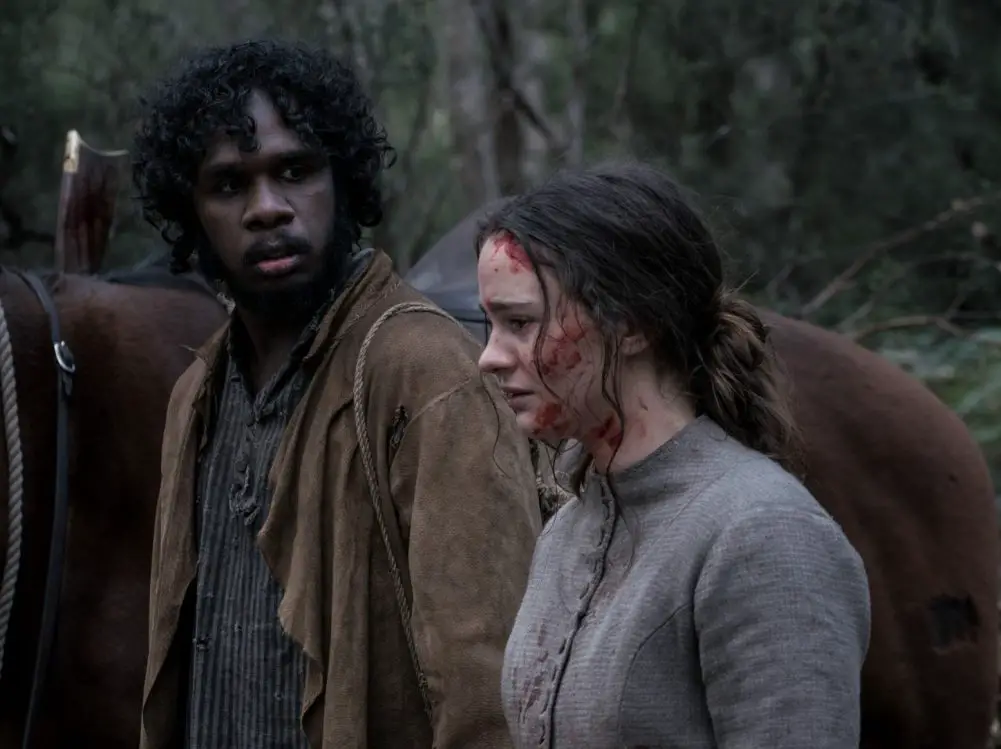Marred by violence and cruelty, but also awash with mercy and compassion, the human narrative is full of complexity and ambiguity. And in 1825, Van Diemen’s Land was a prime example of how someone can be both oppressed and an oppressor, both a victim and victimizer. This is the reality of colonial Australia’s Black Wars. This is the story “The Nightingale” tells.
Director Jennifer Kent (“The Babadook”) reimagines the colonial narrative in her new film by focusing on more minute, but imperative, historical details that are often overlooked in cinema. From the use of racially accurate actors to the incorporation of native Irish and Aboriginal languages to frank representations of blurred power structures, Kent creates a period piece that illuminates an era of exploitation without re-victimizing those who suffered under its system.
When Clare, a 21-year-old Irish convict (Aisling Franciosi), is denied release after serving her seven-year sentence, a confrontation ensues between her husband (Michael Sheasby) and her oppressive master, British lieutenant Hawkins (Sam Clafin). The encounter leaves Clare burning with hatred for Hawkins and his loyal following.
As British colonial authorities refuse to take the word of an Irish criminal over that of an officer, the devastated woman turns her sorrow to determination. Driven by an unchecked passion for justice, and revenge, Clare hires Billy (Baykali Ganambarr), a tracker from the Letteremairrener Clan, to lead her through the Tasmanian wilderness in pursuit of Hawkins.
Since its inception, “The Nightingale” was destined to be unlike most other period films. Kent, tired of the cinematic trend of romanticizing the past, was dedicated to telling a historically accurate story, despite how painful it might be to watch. Such a goal took meticulous research into set location, casting choices and traditional customs.
As most of the screen-time focuses on Clare and Billy’s hunt through the woods, Kent brought her team deep into Tasmania to film “The Nightingale” — an endeavor so toilsome that she was astonished the cast and crew were so successful.
Hollywood is continually under fire for “whitewashing” its characters, that is, casting racially inaccurate actors (namely white actors for non-white roles). “The Nightingale,” however, takes pride in its casting selection.
Baykali Ganambarr’s debut role as Billy not only earned him the Marcello Mastroianni Award for best breakout actor, but it was also his chance to bring Aboriginal culture to the big screen. Raised on a small island in Australia’s Northern Territory, Ganambarr is a dancer by training. His dance troupe is an Aboriginal company called Djuki Mala, whose routines blend traditional and contemporary styles.
Billy is portrayed by a racially accurate actor and performs actual Aboriginal dances. In the film, he speaks in Palawa Kani — a dialect created by reconstructing the extinct or near-extinct Tasmanian languages. “The Nightingale” is the first full-length film to feature the dialect, which has allowed the remaining Australian Aboriginals to preserve some of their stolen culture.
“We obviously were very adamant about subtitling it,” Kent told Vox. “We wanted to make sure that the language was understood by [audiences] — because, shockingly, there are films that don’t subtitle indigenous languages.”
Without subtitling Palawa Kani, the beautifully symbolic language is mere gibberish to viewers. It would not inspire compassion or mutual understanding and would further dehumanize the speaker.
Casting decisions and use of traditional dances, rituals and translations of Palawa Kani were all done under the guiding hand of Tasmanian Aboriginal elder Jim Everette. Acting as a spokesperson for his community, Everette worked with Kent and the production crew from the earliest stages of “The Nightingale” to ensure the film was culturally accurate and did not further perpetrate stereotypes.
“We have a long history in Australia of white people making Aboriginal stories without having any consultation,” Kent told The A.V. Club. “There is a danger of colonizing people all over again by making stories without their permission. You’re removing their voice.”
Just as the role of Billy and the portrayal of Aboriginal culture were carefully reviewed for accuracy, so were Clare’s Irish songs. An Irish cultural expert was consulted to ensure the Irish lyrics were accurate and that the songs themselves matched the time period.
Both Clare and Billy feel the chains of British imperialism. They have lost their families, homelands, languages, traditions and freedom. They each have been victimized by the same enemy.
But “The Nightingale” is not a story of heroes and villains. This is not a movie of colonialism that paints clear sides, because, as comforting as that sounds, it is not how the world functions.
When the audience first meets Clare, they may be confused as to whether the opening sequence is in Ireland or Australia. The power dynamic exists solely between the British soldiers and Irish servants — with the Irish hovering just above animals and the British reigning as gods. Clare is clearly a victim, and her family lives among the oppressed and colonized. Hawkins exercises complete control over Clare’s body, family and freedom.
Her second-class citizenship, however, does not negate the possibility that she herself wields power over others. She is violated in grotesquely horrific ways, yet her victimhood does not free her from fault when she victimizes others — namely, Billy.
“Clare is a product of her time,” Kent said. “So, she’s as racist as people would have been back then.”
Once Clare hires Billy as a guide, another aspect of the role she plays is revealed — she is a colonizer. This is especially prominent when one considers her use of the Irish language. Although Irish is her native tongue — a tongue that England tried to steal — it is still foreign to Australia and, particularly, to Billy.
Irish, like the Aboriginal languages, is a language of brutalized people in its own right, but it is on the wrong continent. She brought it here, and she uses it at home — a home built on land stripped from Aboriginal people. Her racism is more direct in her refusal to use Billy’s name, calling him “boy” instead and keeping a gun always trained on him
The Guardian explains Clare’s duel-identity best: “In the end, there is no way to escape your own complicity when you are part of the colonial system — no matter how powerless you yourself are.”
Their shared oppressor and experiences, however, overcome the original racial prejudices each initially held about the other. Billy continues to help Clare long after their original bargain and provides medicinal and spiritual treatment for her nightmares. Up north, where violence against Aboriginals is far worse, Clare uses her social position as a white person to protect him.
“I wanted to place two people in a very difficult situation who normally would have nothing in common and would not connect,” Kent explained. “And, in fact, would even be fearful of each other or at least disdainful of each other.”
Audiences should take a note of caution: though the film does focus on compassion between two people who are initially reviled by the other, “The Nightingale” is not a kind film. Just as the intricacies of Irish and Aboriginal culture are portrayed with careful accuracy, the physical violence is viciously realistic.
White men murder Aboriginal men, and then, with a chilling ease and calm, take their heads as trophies. Clare barely gives pause when she comes across mutilated bodies hanging in the woods. Also, women are passed between men as casually as one may share a pipe.
“We were all warned about the film’s violence,” The A.V. Club writes. “There was no preparing for its awful power.”
This power overcame audiences to such a degree that many walked out of theaters and movie festivals at its premiere. Critics condemn the film as indulging in violence to the point that the film is completely unwatchable.
Although Kent understands why people chose to exit the theater and feels they have every right to do so, she disagrees with criticisms of its excess. Clare and Billy may be fictional, but their stories are real. People lived through the very acts of degradation and genocide depicted on the screen, and Kent was not going to gloss over it for the sake of a happier movie.
Kent further explains that the scenes of sexual violence were carefully choreographed and rehearsed with as much precision as a dance routine. Actors met with rape crisis counselors and psychologists in order to understand the reality of the effects of sexual violence and to ensure Franciosi and her male colleagues felt supported and safe when embodying these roles.
In its depiction of violence, the film also raises questions about revenge and survival in a time and place that knows no mercy. From the natural danger of the wilderness, to the devastating acts of violation, to the subtle, but degrading, stares and comments from white settlers, “The Nightingale” exists in a vacuum of social dehumanization.
In such a formidable place, how can one seek justice without it becoming revenge? In seeking vengeful justice, is one willing to mutilate themselves? The toll on Clare manifests in life-threatening nightmares. Billy sacrifices his life, and, in doing so, may be sacrificing the last of his people.
“[‘The Nightingale’] acknowledges that killing will haunt you, maybe ruin you even, while also wondering aloud if there’s some evil so deep and oppressive and destructive it must be met with violence.”
















